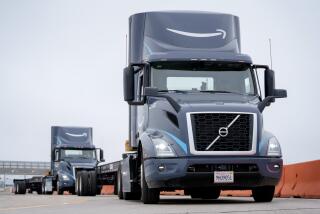Stealth in Living Color
- Share via
To maintain an element of sporting chance in the game that drivers play with the law, the California Highway Patrol cruises state roads in cars that a reasonably alert driver can spot miles away.
But in about two weeks the patrol will start experimenting with 15 patrol cars painted not in black and white but in civilian colors, with no rooftop bar of lights that--even with nothing to go on but a silhouette--is usually a dead giveaway.
The reason for the test is that high speed is no longer a sporting game--especially when it comes to trucks and buses, both of which will be special targets for the new cars. The officers will wear uniforms but the cars will travel in plain clothes, except for standard CHP shields on the doors, in an effort to determine whether they can cut the rate of accidents involving trucks. With the alarming increase in deaths and injuries in truck accidents in recent years, we can only say good hunting, even if it is the end of an era.
Truck safety is a growing concern not only in California but in other states as well. Part of the problem is that California roads are filling up; 20 million cars and trucks are registered in the state now, which means more targets than ever. But it is more complex than that.
In a recent spot check the Highway Patrol found that nearly 40% of the trucks were running with brakes so soft or tires so worn or other problems so serious that the trucks had to be ordered off the road. Failures in a recent New York state check reached 60%. Since California’s Public Utilities Commission loosened regulations, the average age of trucks on the road has climbed from just over four years to just over six years.
Common sense says that some of the deterioration stems from the deregulation of freight rates in 1980 that increased competition, drove down trucking profits and forced truckers to skimp on maintenance. Competition probably also leads too many drivers to spend 16 to 20 hours a day on the road, too many of them running on amphetamines.
Add to those factors high speed, sudden lane changes and, by some accounts, a new generation of drivers without the training or the attitude of the old pros, and you have a set of statistics showing a steady rise in California accidents caused by trucks. In 1984 alone the number jumped by nearly 20%. Every three days, on the average, there is a truck accident serious enough to tie up at least part of a freeway in the Los Angeles area.
The task of reversing the trend to make trucks safer each year rather than more dangerous will take more than good police work.
Congress took one small step late this year with a new law requiring truck drivers to carry a national license. That should end a common practice of carrying licenses from several states and showing police only the one that has the fewest marks against it. It also would mean that truck drivers would have to pass a driving test in a truck and not, as is possible in many states, in a subcompact automobile.
The California Public Utilities Commission, acting on the common-sense view that lower profits mean less maintenance, has allowed truckers some more freedom to raise rates, although few take advantage of it because of the competition. It also is searching through the records trying to determine whether common sense is right to make deregulation the culprit.
So for now the burden is on the Highway Patrol, including its new fleet of stealth patrol cars. For our part, we are prepared to give up our sporting chance with Smokey if the new cars make it possible to catch more of the worst offenders.
More to Read
Sign up for Essential California
The most important California stories and recommendations in your inbox every morning.
You may occasionally receive promotional content from the Los Angeles Times.










